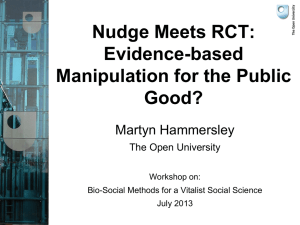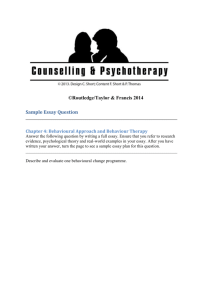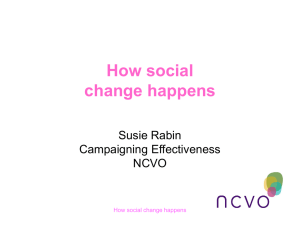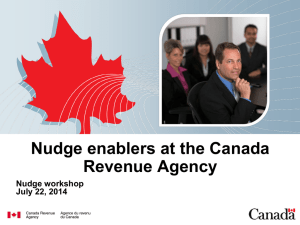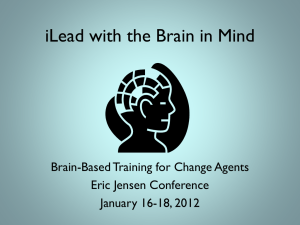Designing for Nudge Effects: How behaviour management
advertisement
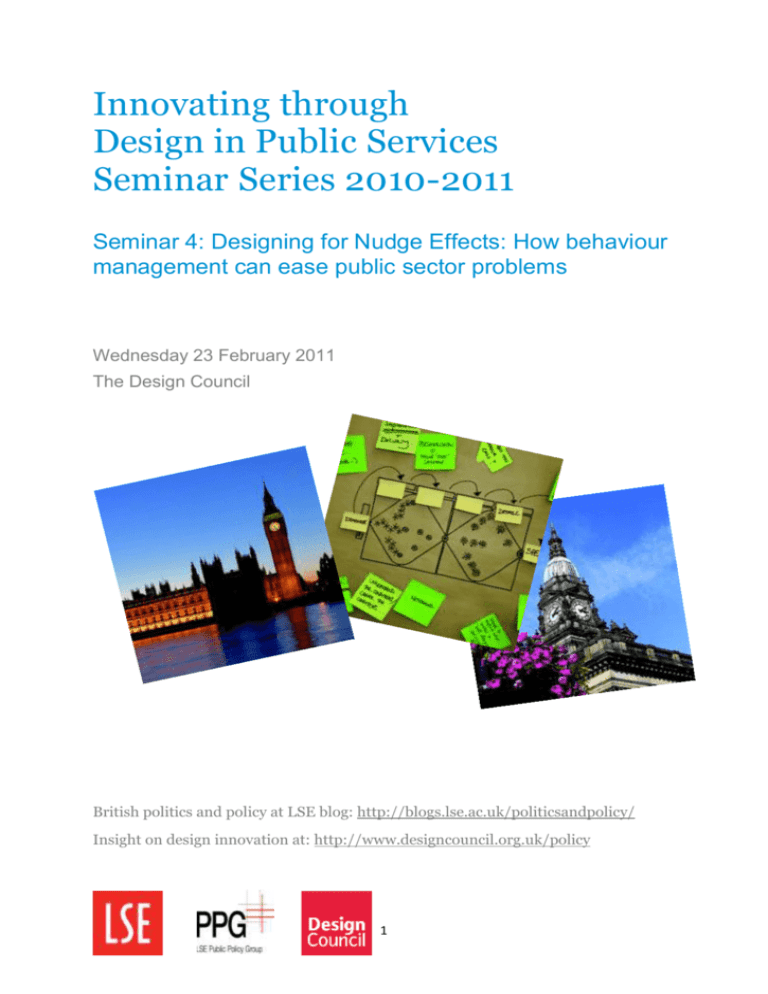
Innovating through Design in Public Services Seminar Series 2010-2011 Seminar 4: Designing for Nudge Effects: How behaviour management can ease public sector problems Wednesday 23 February 2011 The Design Council British politics and policy at LSE blog: http://blogs.lse.ac.uk/politicsandpolicy/ Insight on design innovation at: http://www.designcouncil.org.uk/policy 1 Designing for Nudge Effects: How behaviour management can ease public sector problems Paul Rainford and Jane Tinkler What is ‘Nudge’? In 2008 Richard Thaler and Cass Sunstein published a book entitled Nudge: Improving Decisions About Health, Wealth, and Happiness. It draws on behavioural economics and social psychology to ‘explain why people behave in ways that deviate from rationality as defined by classical economics’ (Marteau et al., 2011: d228). Indeed, ‘traditional economics holds that humans, as rational beings, make choices to maximise their welfare. Behavioural economics meanwhile relies on cognitive-psychology research to relax those assumptions, teaching instead that humans have “bounded rationality” and so make biased decisions that sometimes run counter to their best interests’ (Stewart, 2005). Thaler and Sunstein thus expound a theory of libertarian paternalism. They believe it is legitimate for governments to design environments and contexts - the “choice architecture” - in which people make decisions in order to make it easier for them to maximise their well being. They counterbalance this by an insistence that people should ultimately still be free to make their own decisions as the choice architecture ‘should be unobtrusive and not entail compulsion’ (Bonell et al. 2011: d401). As such, a ‘nudge’ entails ‘any aspect of the choice architecture that alters people’s behaviour in a predictable way without forbidding any options or significantly changing their economic incentives’ (Thaler and Sunstein, 2008: 6). Nudge ‘excludes legislation, regulation and interventions that alter economic incentives’ (Marteau et al., 2011: d288) but it instead includes a variety of soft touches as outlined by Bonell and colleagues (2011): ‘Nudges might involve subconscious cues (such as painting targets in urinals to improve accuracy) or correcting misapprehensions about social norms (like telling us that most people do not drink excessively). They can alter the profile of different choices (such as the prominence of healthy food in canteens) or change which options are the default (such as having to opt out of rather than into organ donor schemes). Nudges can also create incentives for some choices or impose minor economic or cognitive costs on other options (such as people who quit smoking banking money they would have spent on their habit but only being able to withdraw it when they test as nicotine free)’. 2 As Marteau et al. (2011: d228) note, ‘the appeal of nudging [for government] is self evident: it proposes a set of seemingly simple, low cost solutions that do not require legislation and can be applied to a wide array of problems arising from our behaviour’. In addition, ‘the absence of legislation holds particular appeal for governments and others wanting a smaller role for the state in shaping the behaviour of its citizens’. However, ‘there is no precise, operational definition of nudging. This may reflect a reality —namely, that nudging is at best a fuzzy set intended to draw attention to the role of social and physical environments in shaping our behaviour and not to inform a scientific taxonomy of behaviour change interventions’ (Marteau et al., 2011: d228). Bonell and colleagues (2011: d401) attempted to outline possible uses of nudge in relation to public health and the regulatory actions that would be needed to back up nudge effects. Figure 1: Examples of nudging and regulating actions Smoking Alcohol Diet Physical Activity Nudging Regulating Make non-smoking more visible through mass media campaigns communicating that the majority do not smoke and the majority of smokers want to stop Ban smoking in public places Reduce cues for smoking by keeping cigarettes, lighters and ashtrays out of sight Serve drinks in smaller glasses Increase the price of cigarettes Regulate pricing through duty or minimum pricing per unit Make lower alcohol consumption more visible through highlighting in mass media campaigns that the majority does not drink to excess Designate sections of supermarket trolleys for fruit and vegetables Raise the minimum age for the purchase of alcohol Make salad rather than chips the default side order Make stairs, not lifts, more prominent and attractive in public buildings Ban industrially produced trans fatty acids Increase duty on petrol year on year (fuel price escalator) Make cycling more visible as a means of transport, e.g. through city bike hire schemes Enforce car drop-off exclusion zones around schools 3 Restrict food advertising in the media directed at children The benefits and problems with the nudge approach As outlined above, the possibilities that nudge effects could bring to public sector problems, especially at a time of stretched resources are exciting for government. By presenting a clear ‘right’ choice, those who are undecided, don’t care or wanted additional information before deciding could be encouraged to make a better choice for themselves than they otherwise might have done. However, critics of nudge and libertarian paternalism argue that ‘attempts to change people’s lifestyle choice are potentially patronising and condescending’ and embody ‘excessive state interference. The use of public authority to change citizens’ behaviours, even if the altered behaviours are better for the citizens themselves, violates spheres of privacy, integrity, integrity and autonomy... The state ought not to patronise people, by singling out a subset of the population and treating them as if they lacked the full use of reason’ (Oliver and Brown, 2010). Against this charge, Thaler and Sunstein note that ‘there is no such thing as neutral design. Some organisation or agent must... provide starting points of one kind or another. This is not avoidable. As such, the anti-nudge position is unhelpful – a literal nonstarter’ (Thaler and Sunstein, 2008: 10-11). Indeed, ‘once you know that every design element has the potential to influence choice, then you either close your eyes and hope for the best, or you take what you know and design programmes that are helpful’ (Stewart, 2005). Thaler and Sunstein could have developed their argument further by suggesting that ‘if engaging in a certain type of activity – not taking medicine, obesity, smoking – poses avoidable harms (or costs) for individuals or for the communities in which they live, then the societal view may be that, coercive or otherwise, nudge techniques are justifiable in this context’ (Oliver and Brown, 2010). Another criticism of this approach has focussed on whether designing cues to prompt desirable behaviour can translate into sustainable public policy on a macro-level, or whether the proposals merely provide ‘cute technocratic solutions to mainly minor problems’ (Chakrabortty, 2010). Indeed an article by Bonell and colleagues in the British Medical Journal expressed concern that ‘to date, few nudging interventions have been evaluated for their effectiveness in changing behaviour in general populations and none, to our knowledge, has been evaluated for its ability to achieve sustained change of the kind needed to improve health in the long term’ (Bonell et al., 2011: d401). Moreover, ‘effective nudging may require legislation, either to implement healthy nudges (such as displaying fruit at checkouts) or to prevent unhealthy nudges from industry (such as food advertising aimed at children)... Without regulation to limit the potent effects of unhealthy nudges in existing environments shaped largely by industry, nudging towards healthier behaviour may struggle to make much impression on the scale and distribution of 4 behaviour change needed to improve population health to the level required to reduce the burden of chronic disease in the UK and beyond’ (Marteau et al., 2011: d228). For example, a voluntary agreement between food manufacturers and the Food Standards Agency in the UK resulted in a 0.9g per person decrease in daily salt consumption, which compares poorly to the reductions of 5g per person in Finland and Japan as a result of enacting relevant legislation (Marteau et al., 2011). It may be therefore that focussing on nudge activities could prove wasteful ‘if an emphasis on nudging resulted in neglect of population level interventions that were potentially more effective’ (Marteau et al., 2011). This is even more true if one takes issue with the fundamental assumption underpinning the nudge agenda – namely that ‘if people act against their own best interests – by using drugs, eating junk, failing to save or taking loans they can’t repay – it is because of individual behavioural flaws, not because of poverty, inequality or lack of hope’ (Wilby, 2010). In this view, nudge’s (mistaken) premise is ‘to make people fit for markets, not the other way round’ (Wilby, 2010), and cynics would suggest that its popularity stems from the fact that ‘it is cheaper than really liberating people through true equality, opportunity and minimisation of the wealth divide’ (Guardian, 2010). How does the Government propose to use nudge? One of the Coalition Commitments from May 2010 pledged to incorporate nudge insights into the wider policy planning agenda: There has been the assumption that central government can only change people’s behaviour through rules and regulations. Our government will be a much smarter one, shunning the bureaucratic levers of the past and finding intelligent ways to encourage, support and enable people to make better choices for themselves (Cabinet Office 2010: 4). The Behavioural Insights Team was subsequently created and is now based in the Cabinet Office. It is tasked with working in the following areas: Improving the nation’s health Empowering consumers and encouraging people to give money Protecting the environment The Unit will draw on the MINDSPACE framework (as shown in Figure 2) ‘to support the work of those making decisions that impact upon the health and wellbeing of citizens’ (Cabinet Office and the Institute for Government, 2010). Figure 2: A summary of the main influences outlined in the MINDSPACE framework 5 Messenger We are heavily influenced by who communicates information Incentives Norms Our responses to incentives are shaped by predictable mental shortcuts such as strongly avoiding losses We are strongly influences by what others do Defaults We ‘go with the flow’ of pre-set options Salience Our attention is drawn to what is novel and might seem relevant to us Priming Our acts are often influenced by sub-conscious cues Affect Our emotional associations can powerfully shape our actions Commitment We seek to be consistent with our public promises and reciprocate acts Ego We act in ways that make us feel better about ourselves The nudge agenda can already be seen to have been adopted by policymakers in these areas. Health Secretary Andrew Lansley’s November 2010 White Paper on public health emphasised that ‘nudging people to behave in certain ways should be the main approach taken in public health from now on’ (Curtis and Campbell, 2011), and a report entitled Applying Behavioural Insight to Health (2010) laid out nine case studies in which new or trial programmes would be implemented. This included the use of social norm techniques for tackling excess alcohol consumption in universities, a prompted choice system for organ donation, and smoking cessation trial in partnership with Boots. Research experiments using ‘nudge’ and ‘think’ An academic team led by Professors Peter John from the University of Manchester and Gerry Stoker from the University of Southampton have been looking in more detail at what citizens can do to help create and maintain a good society, and how governments and other agencies can help to stimulate citizen action. The team has carried out a range of research developing innovative experiments on charitable giving, recycling, volunteering, and people deliberating controversial topics online. They used a range of methods including randomised control trials to get a robust evidence base about ways to change civic behaviour. Their research is specifically situated to look at policy debates about the provision of public services in a period of austerity. This includes seeing locally-based innovation as a way to get 6 value for money in public sector provision and that citizens are willing to change their behaviour and do more to help themselves and others. The research was framed around two ideas – ‘nudge’ and ‘think’. Think draws on a different tradition to nudge in that it argues that it is possible to get citizens to think through controversial issues in innovative ways that allows for evidence and the opinions of all to count. 7 Figure 3: ‘Nudge’ and ‘think’ approaches compared Nudge Think View of preferences Fixed Malleable View of subjects Costs to the individual Cognitive misers, users of shortcuts, prone to flawed and sometimes befuddled thinking Low but repeated Reasonable, knowledge hungry and capable of collective reflection High but only intermittently Unit of analysis Individual focussed Group focussed Change process Cost-benefit led shift in choice environment Increasing the attractiveness of positive sum action Customise messages, expert and teacher Value led outline of new shared policy platform Addressing the general interest Goes with the grain of decision making, low cost, sustainable renewal, wide application Does not address fundamental divisions, overall modest outcomes Addresses the root of the problem, new ways of thinking, may lead to changes needed Time consuming, prone to manipulation and failure Civic conception Role of the state Create new institutional spaces to support citizen-led investigation, respond to citizens Summary Strengths Weaknesses Three of the team’s research experiments are detailed below: Research Experiment 1: The Use of Feedback to Enhance Environmental Outcomes: a Randomised Controlled Trial of a Food Waste Scheme (a nudge experiment) The first experiment was designed to test whether giving people feedback on their street recycling rate promotes participation in a kerbside food waste collection scheme. In the context of the government’s target that by 2020 biodegradable municipal waste going to landfill must be 35 per cent of the amount produced in 1995, this research is of critical future import. The disposal of biodegradable waste to landfill results in emissions of methane and contributes to global warming, and food waste disposal is cheaper per ton (£52) than general waste disposal (£85). In collaboration with Oldham Council and EMERGE recycling (a social enterprise), 318 streets (9,082 households) were randomly assigned to either a treatment or control group. Each household in the treatment group received postcards giving feedback on the recent recycling performance of their street compared to other nearby streets. Streets performing 8 above the average got a ‘smiley face’ postcard. Streets below the average got a ‘frown face’ postcard. These treatments arose from previous studies that found that behaviour is influenced by social norms, and that the extent of pro-social behaviour is often underestimated. Observation of the food waste containers was performed by monitors on collection day over a three week period. A baseline was taken for three weeks in August 2009, and a follow up for 1-3 weeks in September 2009 and then 2-3 weeks in October 2009. A binary measure of whether the household was a recycler or a non-recycler was calculated, with a recycler classed as a household which puts out a food waste container at least one week in three. Overall, providing feedback cards to households had a positive impact, raising participation in the food waste scheme by three percentage points, an increase of 6 per cent. Figure 4: Proportion of households recycling food waste 53 52 51.96 51.49 50.65 51 50.08 50 49 Control 49.08 Trea tment 48.12 48 47 46 ba s el i ne 1s t fol l ow-up 2nd fol l ow-up Both the smiley and frown feedback were effective: positive feedback encouraged those in high performing streets to carry on making the effort, while negative feedback persuaded those in low performing streets to join in with the food waste collection scheme. Feedback was most effective with households who were not currently recycling their food waste however it acted to discourage some existing recyclers. Feedback was most effective when given more than once, to re-iterate the message. Households who received two smiley cards or two frown cards were more likely to respond than those who received mixed messages. Research Experiment 2: Testing the Effectiveness of Pledging and Publicity in Encouraging Charitable Donations (a nudge experiment) This experiment was designed to measure the effectiveness of pledging and publicity in encouraging charitable donations. Behind this experiment is research that shows once 9 someone makes a conscious choice or stand, they encounter pressures to keep that behaviour going. Then by making that choice or stand public, there is more chance that the chosen behaviour will be more pro-social. Previous research has suggested that pledges work best if they are written down, made public, done in groups, voluntary and combined with other marketing approaches. This form of nudging may have an impact on - for example - promoting the use of seatbelts and cycle helmets, and also encouraging voter registration and voter turnout. A book collection was organised jointly by the University of Manchester and the charity Community HEART, with the support of Manchester City Council. Letters were sent to 12,000 households in Manchester asking them to donate a book to help set up school libraries in South Africa. Households were randomly assigned to three groups: Pledge group – who received a letter advertising the book collection and asking them to pledge a book; Pledge and publicity group – who received a letter, were asked to pledge and were told that a list of donors would be displayed in the local drop-off points; Control group – who just received a letter. 10 Figure 5: Results for Pledge and Donations across the three treatment groups Pledges Pledge Group (%) Pledge and Publicity Group (%) Control Group Households made a pledge 5 6 0 Households did not pledge 95 94 100 Donations Pledge Group (%) Pledge and Publicity Group (%) Control Group Book donation 8 9 7 No book donation 92 91 93 As shown in Figure 5 above, both treatments had a positive effect. There were in total 948 book donors ( from 8 per cent of households) from both deprived and affluent areas who donated 6,894 books of exceptional quality. Each donor gave on average seven books with libraries the most popular drop-off point (70 per cent). Asking households to pledge by itself did not increase book donations significantly beyond simply asking people to donate. The offer of public recognition for the donation, together with the pledge, had the most impact, raising the number of donations from 7 per cent of population to 9 per cent, an increase of 22 per cent. Research Experiment 3: Online Deliberation Experiment (a think experiment) Six thousand participants were recruited from an online panel and randomly allocated to four treatment and two control groups. Two deliberation groups were invited to participate in an online discussion focused on their attitudes and views on government policy towards anti-social behaviour (ASB) and community cohesion. Two information-only groups had access to the same boards, but were only able to post their own comments - they could not read the comments of other participants. 11 Those who posted tended to be female, older, with qualifications and politically interested. Only modest changes in policy preference were found in relation to youth ASB, and only amongst those who posted. The policy preferences of those who posted tended to move away from legal punishment and heavier policing towards the promotions of better role models and improved monitoring of young people by adults. Research Experiment 4: A) The Impact of Discussion versus Information on Organ Donation (a think and nudge experiment) This experiment compared the impact of information alone versus information and discussion on organ donor registration levels. One hundred and eighty students were randomly assigned to three groups to receive one of the following interventions: A four page information booklet encouraging registration, based on the principles of behavioural economics; The booklet followed by a 15 minute deliberation; An information booklet about swine flu (placebo control). After the intervention, students were invited to join the organ donor register. Registration increased across all three groups. However, the information booklet had the greatest effect, and raised the number of students on the organ donor register from 23 per cent to 57 per cent, an increase of 17 per cent. B) Measuring the Influence of Choice Architecture on Organ Donor Registration (a nudge experiment) Four thousand and eleven British adults recruited from an online panel (not on the organ donor register) were randomised into informed consent, mandated choice groups and presumed consent (control). The outcome was measured in terms of visits to the National Organ Donor Register website: • • • 23 per cent of the opt-out group clicked through from the survey to visit the website – a 36 per cent difference; 20 per cent of the mandated choice group clicked through from the survey to visit the website – 54 per cent difference; and 15 per cent of the opt-in group clicked through from the survey to visit the website. However, very few people completed the online registration process on the National Organ Donor Register website. Reflections on the experiments Overall virtually all of the nudge interventions worked. These were small-scale interventions so larger versions could yield bigger results. Local public sector institutions, such as local 12 authorities, were keen to try nudges as low cost ways to generate co-production. Also several of the nudges were delivered jointly with local voluntary organizations who immediately grasped the concept and wanted to apply it in their work. As for the think approach, the research found that large-scale online deliberations can be engaging for significant numbers of citizens and controversial topics can be discussed, but those that do participate tend to be already politically-interested. However it may be possible to use this route to get new voices into public debate if public sector organisations use innovative methods. Think approaches more generally require different ways of working by public sector bodies. Figure 6: Summary of the four research experiments and their results Topic Intervention Nudge or Think Result Food waste Feedback Nudge Food recycling up Charitable giving Pledging Nudge Public pledge works Online forum Debate Think Some opinion shifts Organ donations (2) Choice Nudge and Think Nudge works better Discussion points How do public sector organisations decide what is the ‘good’ behaviour that nudges aim to promote? Where are the limits on what government should attempt to get citizens to do? To safeguard against ‘bad’ nudges or their ‘capture by private interests’ (Thaler and Sunstein, 2008), a transparent system of monitoring would be needed alongside a broad public debate to assess the ‘acceptability, justifiability and limits’ of nudge interventions (Oliver and Brown, 2010). By allowing the public to choose between a range of options, costs may actually increase but to close down methods of service provision would be to take away choice from the public which would be against Thaler and Sunstein’s vision. Nudges may only make limited difference and focus on them may take away from more difficult but more effective reforms. 13 Current versions of nudge do not seem to have citizen involvement in their origin or design. ‘Think’ approaches may be used by organisations to identify citizen views before nudge ideas are operationalised. Further Reading Bonell, C. et al. (2011) ‘One Nudge Forward, Two Steps Back’, British Medical Journal, 342: d401. Cabinet Office and Institute for Government (2010) MINDSPACE: Influencing Behaviour through Public Policy. London: The Stationary Office. Cabinet Office (2010) Applying behavioural insight to health. Behavioural Insights Team. London: The Stationary Office. Chakrabortty, A. (2010) ‘Cameron’s hijacking of Nudge theory is a classic example of how big ideas get corrupted’, Guardian, 7 December. Curtis, P. and Campbell, D. (2011) ‘Doubts cast on coalition’s ‘big society’ and nudging tactics’, Guardian, 26 January. Department of Health (2010) Healthy Lives, Healthy People: Our Strategy for Public Health in England. London: The Stationary Office. Guardian (2010) Pass notes No. 2,890: The Nudge Unit, 30 November. John, P. and Stoker, G. (2010) How experiments can help get Britain to the Big Society. Available from: http://www.civicbehaviour.org.uk/. Marteau, T. et al. (2011) ‘Judging Nudging: Can Nudging Improve Population Health?’, British Medical Journal, 342: d228. Oliver, A. and Brown, L.D. (2010) On the Use of Personal Financial Incentives to Address Health Inequalities. LSE working paper. Osborne, G. (2008) ‘Nudge, nudge, win, win’, Guardian, 14 July. Stewart, S.A. (2005) ‘Can Behavioural Economics Save Us From Ourselves?’, The University of Chicago Magazine, 97: 3. Thaler, R. and Sunstein, C. (2008) Nudge: Improving Decisions about Health, Wealth, and Happiness. Yale CN: Yale University Press. Wilby, P. (2010) ‘The kindly words of Nudge are Cameron’s ideal veneer’, Guardian, 15 August. Supported by: 14

